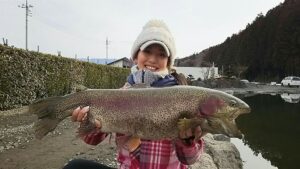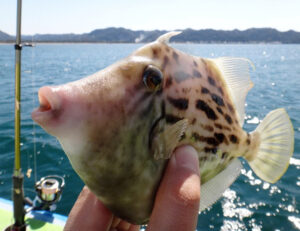Mebaring; Big Fun of Catching Small Rock Fish
Japanese people are very good at finding pleasure in small things. For example, traditional ones are Bonsai and Netsuke, and modern ones are Nanoblock (Lego style blocks but in extreme small size), and miniature figures.
Fishing is no exception. We are having fun catching small fish with fine fishing tackles. Tanago fishing is one of them in the freshwater. There are some more instances in saltwater fishing. One of them is Mebaru fishing, often called Mebaring among Japanese anglers.
This article is about this Mebaring. First part is about this fish species, and the second part will be about Mebaring, the modern style of Mebaru fishing. Lastly I will consider the connection of this Japanese style and the similar styles in the other parts of the world.
Species
Mebaru (Japanese red sea perch, Sebastes inermis) looks like a perch. They are both in the ray finned fish (Actinopterygii). While they are in different families, as our instinctive differentiation tells us, they are quite close. Mebaru is in the group labeled often as rockfish with stings in the fin (Scorpaenidae family), and perch is labeled as freshwater ray-fish (Percidae family). From the angler’s point of view, perch is, by definition, freshwater version of rockfish, or Mebaru is saltwater version of perch.
In Japan, the so-called Mebaru includes the three species, specifically. They are the red one (a kind of standard one), black one and white one. They all look similar, sharing the similar distribution and habitat.
Mebaru is distributed widely in Japan, from southern Hokkaido to Kyushu, and in the eastern and southern coasts of Korea. It prefers to live in the rocky coastal area, often with dense sea weeds.
Its living depth range is up to the depth where seaweeds can grow, since their life cycle is dependent on these vegetation.
It gives birth to baby fish, after the female holds the eggs inside until baby fish are hatching. Baby fish are growing in the seaweeds. It is said that the birth timing is from December to February.
They get bigger by 5 to 6 cm in a year and grow up to 30 cm in about 10 years. The official record of JGFA (Japan Game Fishing Association) is 34.5 cm.
Despite the label “rockfish,” it is often in the middle of the water, though the bigger fish tends to be staying close to the rocky bottom.
Mebarus are feeding on various kinds of foods. Though anglers think that they are predatory fish and they are chasing the small fish and small squids, they are actually eating a lot of easy-to-get polychaete creatures. While some polychaete species in Japan swim in the water, at certain times of the year for spawning, these fish are living on them. It goes well with our understanding of Mebaru that they swim around in the middle water. They may be more flexible in hunting for their food, and they might be searching for worms as they do for shrimps.
Their active time to follow bait is during the night, as their baits are coming up in the middle water then. However, anglers can catch them during the daytime, often at the bottom. It may mean that they are staying at the bottom mainly during the day and swimming around during the night.
Mebaring, lure fishing for Mebaru
As it was explained at the beginning, Japanese lure anglers call the lure fishing for Mebaru Mebaring.
Its basic style is using a jig head and a soft lure. The jig head weights are 1 to 2 grams with soft lures of about 5 cm or 2 inches.
Other types of lures are hard lures, such as minnows, lipless minnows, pencil baits, sinking pencil baits and poppers, of up to 7 cm. And micro metal jigs are other alternatives.
In addition to these conventional selections, we now have these types of lures for Mebaring.
Kabura (ultra light feather jig) and no sinker soft lure with a casting float .
Kabura for Mebaru is the combination of a light jig head and feathers or with the fish skin. Some of you noticed that “Kabura” must be the name of the rig for the red seabream. You are right. There is “Kabura” for red seabream. As the original word of “Kabura” means the rig of a hook with a lead head. Or in other words, Kabura stands for a Japanese traditional jig head.
Here, Kabura in Mebaring is like this.
Another key item Mebaring is a casting float.
Since Mebaru is feeding on the worms, anglers thought about it in the match-the-bait spirit. With no-sinker soft lures, anglers can present their lures in the most natural way. These flies have small mass, soft, flexible and light.
You should ask here, how you can cast them.
Our solution is to have an additional casting float or additional sinker in the leader. This concept is close to Italian Sbirolino or bombarda rigs.
Normally, this style line through float is hard to be replaced. Japanese creativity made it easier, and products like this do not force you to cut the line off to replace.
For this Mebaring requires very fine lines with light lures, rods have softer and sensitive tips. While their rod selection is to go with finer tips, it is notable that skilled anglers are detecting bites with the movement of slack line.
Application of Mebaring to the other parts of the world
As I mentioned in the species section, Mebaru is very similar to perch. They both are swimming in the middle water or even close to the surface, if the situation allows. They are feeding on various food sources.
In this respect, most of the Mebaring methods can be used for perch, and the perch fishing methods can be used in Mebaring. This is already happening in many parts of the world, but there are more rooms for change in both waters.
In your local lakes, you can try to cast a streamer fly with a casting float, using a very thin braided line. On the Japanese coast, we may try to use the micro jig for ice fishing. I am sure some Japanese will like it from the miniature loving cultural background.
It is a great pleasure for me to look at Japanese local target fish and find the similarity of it in other parts of the world. There are differences between people and cultures or diversities in the world. In my opinion, to look at some bits of similarity can be a good start to create something new in the world.the world. In my opinion, to look at some bits of similarity can be a good start to create something new in the world.

